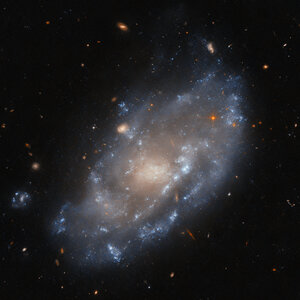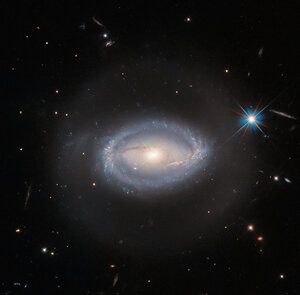

Power across the spectrum
The Hubble Space Telescope has a lot to show in this week’s Picture of the Week. Its view here is studded with stars, many of which appear particularly large and bright thanks to their nearby locations in our own galaxy, and which feature the characteristic diffraction patterns caused by Hubble’s optics. Much further away — around 240 million light-years distant, in fact, in the southern constellation Telescopium — is the spiral galaxy IC 4709. Its swirling disc filled with stars and dust bands is beautifully captured, as is the faint halo surrounding it. The compact region at its core might be the most remarkable sight, however: this is an active galactic nucleus (AGN).
If IC 4709’s core were just filled with stars, it would not be nearly so bright. Instead it hosts a gargantuan black hole, 65 million times the mass of our Sun. A disc of gas spirals around and eventually into this black hole, with the gas crashing together and heating up as it spins. It reaches such high temperatures that it emits vast quantities of electromagnetic radiation, from infrared to visible to ultraviolet light and beyond — in this case including X-rays. The AGN in IC 4709 is obscured by a lane of dark dust, just visible at the centre of the galaxy in this image, which blocks any optical emission from the nucleus itself. Hubble’s spectacular resolution, however, gives astronomers a detailed view of the interaction between the quite small AGN and its host galaxy. This is essential to understanding supermassive black holes in galaxies much more distant than IC 4709, where resolving such fine details is not possible.
This image incorporates data from two Hubble surveys of nearby AGNs that were identified by the Swift X-ray/UV telescope, as does the image from last week. Swift will collect new data on these galaxies — with an X-ray telescope, it’s possible to directly see the X-rays from IC 4709’s AGN breaking through the obscuring dust. ESA’s Euclid telescope — currently surveying the dark Universe in optical and infrared light — will also image IC 4709 and other local AGNs. The complementary use of space telescopes across the electromagnetic spectrum is key to fully researching black holes and their impact on their host galaxies.
[Image Description: A spiral galaxy is situated right of centre. It has a white, brightly-shining core, a glowing disc which is thick with swirling patterns of dark dust, and a faint halo around the disc. It is on a black background with some small, distant galaxies and some foreground stars around it. Six stars along the left side appear particularly large and bright, with two opposing sets of spikes surrounding each one.]





